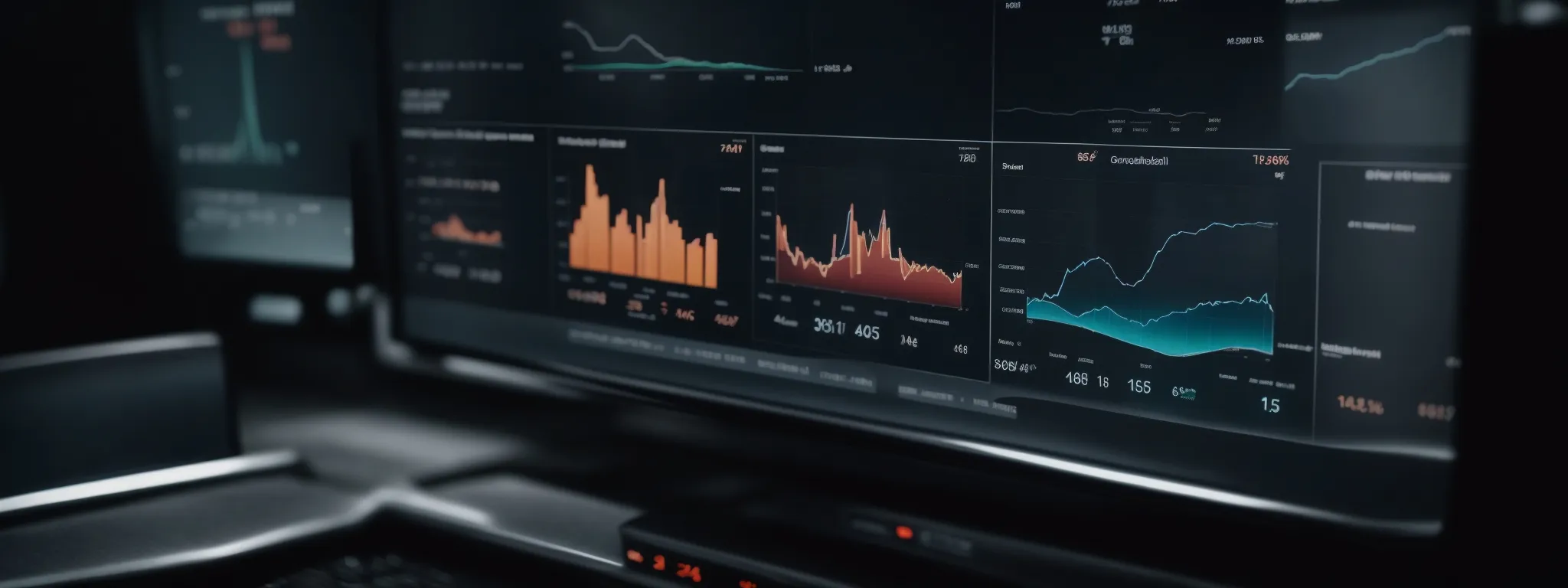Key Performance Indicators in Digital Marketing
Essential Key Performance Indicators for Successful Digital Marketing Strategies In the dynamic landscape of digital marketing, Key Performance Indicators (KPIs) serve as the navigational stars guiding businesses […]
Essential Key Performance Indicators for Successful Digital Marketing Strategies
In the dynamic landscape of digital marketing, Key Performance Indicators (KPIs) serve as the navigational stars guiding businesses toward their desired outcomes.
Crafting a digital marketing strategy without understanding and measuring the relevant KPIs is akin to sailing a ship without a compass.
From website traffic and conversion rates to customer engagement and email campaign effectiveness, these metrics encapsulate the essence of a campaign’s success.
They enable organizations to pinpoint strengths, uncover opportunities for improvement, and prove the return on marketing investments.
Keep reading to uncover the vital KPIs that will ensure your digital marketing strategies are on the path to success.
Key Takeaways
- KPIs Guide Digital Marketing Strategies and Provide Measurable Goals for Success
- Distinction Between Vanity Metrics and Actionable KPIs Is Crucial for Meaningful Results
- Understanding and Optimizing Conversion Rates Is Fundamental in Digital Marketing
- Engagement and Retention KPIs Are Vital in Assessing Customer Satisfaction and Loyalty
- Email Marketing Remains a Powerful Tool for Engagement and Driving Revenue Growth
Understanding the Role of KPIs in Digital Marketing

In the digital landscape, where every click, impression, and conversion can be tracked and analyzed, key performance indicators (KPIs) serve as the navigational beacons guiding marketing teams towards their goals.
These metrics, rooted in data analytics, enable organizations to quantify their marketing activities’ successes and uncover areas ripe for optimization.
Defining the correct KPIs in the context of digital strategies anchors marketing efforts in tangible outcomes.
As businesses strive to meet their Marketing Objectives, the importance of measurable objectives comes to the forefront, with the alignment of KPIs and marketing goals carving the path for not just any digital performance, but one that resonates with the strategic vision of the company.
Defining KPIs in the Context of Digital Strategies
Defining KPIs necessitates a deep understanding of an organization’s unique objectives and the digital marketing channels it employs. A meticulously chosen set of KPIs acts as a mirror reflecting the effectiveness of marketing strategies and digital campaigns.
Each KPI functions as a critical performance metric, shedding light on various facets of digital marketing efforts such as lead generation, conversion rates, or customer retention. Marshaling the right KPIs for digital marketing strategies ensues from the alignment of these metrics with overarching business goals:
- Conversion Rate: Reveals the percentage of visitors who take a targeted action, illuminating the effectiveness of landing pages and CTA implementations.
- Customer Acquisition Cost (CAC): Measures the cost involved in acquiring a new customer, a pivotal metric for evaluating the sustainability and efficiency of marketing initiatives.
- Customer Lifetime Value (CLV): Estimates the total revenue a business can expect from a single customer account, underscoring the long-term value of marketing campaigns.
The Importance of Measurable Objectives
In the competitive realm of digital marketing, measurable objectives act as vital benchmarks for gauging progress and imparting clarity to marketing teams. By establishing quantifiable goals, organizations can track incremental progress and adjust strategies in real time, ensuring resources are pinpointed towards the most profitable marketing activities.
Measurable objectives enable a company to transition from abstract aspirations to concrete achievements, providing a clear roadmap for success. This pragmatic approach not only bolsters a marketing team’s ability to demonstrate their impact on the organization’s bottom line, but it also facilitates informed decision-making grounded in performance data.
Aligning KPIs With Marketing Goals
Within the realm of digital marketing, the harmonization of KPIs and marketing goals is akin to a symphony where each note must align to create a compelling melody: every marketing strategy sings a unique tune, requiring specific KPIs to measure its success. For instance, a campaign geared towards boosting brand awareness will have distinct benchmarks compared to one that aims for increased sales.
- Brand Awareness: Tracking metrics like social media followers and web traffic.
- Sales Increase: Assessing conversion rates and average order values.
A core aspect of aligning KPIs with marketing goals lies in the identification of performance indicators that resonate with the intended outcomes of a campaign. A decisive marketing team aligns its KPI tracking with company objectives, evolving from reactive patterns to a proactive stance in strategy development.
Top KPIs for Evaluating Your Digital Marketing Strategy

In the intricate tapestry of digital marketing, the value of KPIs transcends mere metrics, serving as the backbone for strategic decision-making.
Marketers must carefully distinguish between vanity metrics that offer superficial insights, and actionable KPIs that drive real business growth.
The delicate dance of balancing short-term and long-term indicators is also crucial, with the former pointing to immediate campaign adjustments and the latter to sustainable success.
Recognizing and measuring the right KPIs enables marketers to construct and refine digital strategies that are both responsive and result-oriented, ultimately maximizing digital marketing ROI.
Distinguishing Between Vanity Metrics and Actionable KPIs
In the digital marketing arena, discerning between vanity metrics and actionable KPIs is pivotal for a marketing strategy that delivers meaningful results. Vanity metrics such as page views or social media followers might inflate perceived performance, yet they lack direct correlation with the core objectives, like revenue growth or customer engagement.
Actionable KPIs, on the other hand, offer relevant insights that empower digital marketers to make informed decisions. Metrics such as conversion rate, customer lifetime value, and customer acquisition cost provide a clearer picture of marketing effectiveness and return on investment, guiding strategies towards substantive outcomes.
Balancing Short-Term and Long-Term Performance Indicators
In the dynamic orbit of digital marketing, striking a balance between short-term and long-term performance indicators is an art that can propel campaigns towards sustained success. Short-term indicators often provide rapid feedback on recent changes in marketing strategies, enabling agile adjustments to optimize immediate engagement and conversion.
Conversely, long-term performance indicators are essential in measuring the enduring impact of digital marketing efforts. They offer insights into the trends over extended periods, informing strategies that contribute to sustained growth and improved digital marketing ROI.
| Performance Indicator | Short-Term Utility | Long-Term Relevance |
|---|---|---|
| Conversion Rate | Gauge immediate campaign effectiveness | Inform on overall strategy and user experience |
| Customer Acquisition Cost (CAC) | Assess cost efficiency of current campaigns | Evaluate long-term profitability and scaling potential |
| Customer Lifetime Value (CLV) | Monitor early customer value trends | Predict future revenue and guide resource allocation |
Analyzing Traffic Growth Through Core KPIs

As digital marketing strategies become increasingly complex and dynamic, understanding the nuances of traffic growth becomes essential.
Traffic metrics offer a direct glimpse into the effectiveness of various marketing initiatives, allowing teams to measure everything from the raw influx of unique visitors and page views to the more in-depth quality analysis of where those visitors originate.
Engagement levels can also be discerned by examining metrics like bounce rate, a telling indicator of how content resonates with an audience.
Each of these facets plays a significant role as pivotal KPIs in the digital marketing landscape, informing strategies that ultimately drive successful outcomes.
Measuring Unique Visitors and Page Views
Accurately gauging the influx of unique visitors is critical in digital marketing as it uncovers the breadth of an audience reach and the appeal of content to new individuals. Tracking page views complements this by revealing the depth of user interaction within a website, providing a window into the content’s ability to retain user attention.
Together, these metrics form the bedrock of Traffic Analysis, granting digital marketing teams vital insights into audience acquisition and behavior. Awareness of these figures is instrumental in assessing the initial impact of digital marketing activities and tailoring strategies to enhance user engagement.
Assessing the Quality of Traffic Sources
When measuring the efficacy of digital marketing efforts, one cannot overlook the importance of scrutinizing the quality of traffic sources. This entails evaluating the origins of web traffic to determine which channels are most effective at attracting not just visitors but the right kind of engaged and relevant audience that aligns with business objectives.
Diligent analysis of traffic sources goes beyond superficial numbers; it involves an exploration of user behavior and interaction patterns in relation to the source. Marketers can use insights from this analysis to refine targeting strategies, thereby enhancing the relevance and impact of digital marketing campaigns, leading to improved conversion rates and ROI.
The Role of Bounce Rate in Understanding Engagement
Bounce rate stands as a critical indicator of visitor engagement and content relevance. When an individual accesses a single page and then leaves without any interaction, this metric captures that lack of engagement, prompting digital marketing teams to investigate and optimize the user experience.
Oftentimes, a high bounce rate may signal content disconnect or website navigation issues, triggering marketing professionals to enhance their content strategy or site structure. By monitoring and reducing bounce rates, businesses can foster improved user retention and ultimately, elevate conversion rates.
Conversion Metrics as Key Indicators of Success

At the juncture where marketing strategies intersect with tangible results, the evaluation of conversion metrics emerges as a vital process for digital marketers.
This analytical approach includes dissecting conversion rates across various digital channels, understanding cost per conversion to manage budgets effectively, and leveraging conversion data to optimize the sales funnel.
These conversion-related insights are indispensable for not only measuring the current performance of campaigns but also for steering future marketing efforts towards greater efficiency and profitability.
Therefore, the mastery of conversion metrics stands paramount in the pursuit of a digital marketing strategy’s success.
Tracking Conversion Rates Across Various Digital Channels
Understanding the nuances of digital marketing often hinges on accurately tracking conversion rates across varied digital platforms. Each channel, whether it be social media, email marketing, or PPC Google Ads management, presents unique opportunities to capture consumer interest and convert it into measurable action.
By continually monitoring and analyzing these rates, digital marketing teams can hone in on the most effective channels for their specific audience, optimizing ad spending and maximizing return on the marketing investment. Strategic adjustments based on conversion data ensure the organization’s digital marketing plan remains both agile and attuned to consumer behavior:
| Digital Channel | Conversion Rate | Strategic Insight |
|---|---|---|
| Email Marketing | Assess engagement and content relevance | Shape direct response campaigns and personalize communication |
| PPC Google Ads | Measure the efficacy of ad copy and keyword targeting | Refine PPC management for enhanced visitor-to-customer conversion |
| Social Media | Evaluate the impact of digital PR strategies on audience action | Adjust content to cater to the propensities of social media followers |
The Significance of Cost Per Conversion in Budgeting
The significance of cost per conversion is crucial in the orchestration of budgeting for digital marketing campaigns. This metric provides a clear understanding of the financial efficiency of different marketing channels, enabling allocation of budgets where the cost of converting a visitor into a customer is optimized.
Discerning the cost per conversion empowers organizations to drive their marketing activity with a focus on ROI, ensuring that ad spending is justified by corresponding conversions. Careful ongoing analysis of this metric aids in the fine-tuning of marketing strategies for enhanced financial effectiveness.
| Marketing Channel | Cost Per Conversion | Financial Efficiency |
|---|---|---|
| PPC Google Ads | Insight into investment per converted click | Adjust ads for optimal cost-effectiveness |
| Social Media Advertising | Evaluation of user acquisition costs | Strive for lower costs with higher conversion rates |
| Email Campaigns | Tracking expenses against email-driven conversions | Refine campaigns for cost-efficient customer engagement |
Optimizing the Sales Funnel With Conversion Data
Conversion data stands as a beacon guiding the refinement of a sales funnel. By analyzing where in the funnel potential customers disengage, a business can pinpoint barriers to conversion and tailor their strategies to improve the customer journey, augmenting the likelihood of finalizing a sale.
This empirical approach to funnel optimization, driven by robust conversion analytics, ensures that each stage of the sales process is as effective as possible. Leveraging such data, digital marketing teams can optimize touchpoints to enhance user experience and seamlessly guide prospects from awareness to purchase, maximizing the strategy’s overall success.
Assessing Customer Engagement and Retention KPIs

In the ever-evolving world of digital marketing, the measurement of customer engagement and retention stands as a cornerstone of success.
The ability to gauge customer satisfaction and loyalty through targeted KPIs is integral to understanding the effectiveness of marketing actions and their subsequent impact on a business’s bottom line.
With a clear focus on key indicators like Net Promoter Score and customer retention rate, digital marketers can align their strategies to bolster customer relationships, optimize lifetime value, and drive sustainable growth.
These measures, reflective of the consumer’s experience and inclination to continue a relationship with a brand, are pivotal in determining the true return on investment (ROI) for digital marketing endeavors.
Evaluating Customer Satisfaction Through Net Promoter Score
The Net Promoter Score (NPS) emerges as a robust gauge for evaluating customer satisfaction within the ambit of digital marketing strategies. This metric captures the likelihood of customers recommending a company’s product or service to others, serving as a direct reflection of the company’s success in building customer loyalty and satisfaction.
Utilizing NPS, digital marketing professionals can distill vast amounts of feedback into actionable data, enabling them to refine their engagement tactics and foster a positive brand image. By measuring such qualitative insight, marketing teams can identify the drivers of customer advocacy and concentrate efforts on reinforcing those strengths, thereby fortifying the foundation for sustained business growth.
Calculating Customer Retention Rate and Its Impact on ROI
Customer Retention Rate is an essential indicator of how successful a brand is at satisfying customers and sparking repeat business, which directly ties into the return on investment from digital marketing efforts. It quantifies the percentage of customers who remain engaged over a specific period, offering a clear snapshot of customer loyalty and the effectiveness of retention strategies.
Understanding this KPI allows companies to gauge the health of customer relationships and forecast long-term profitability. An uptick in retention rate is often a predictor of steady revenue streams and reduced acquisition costs, thus significantly impacting the organization’s overall ROI:
| Retention Metric | Customer Impact | ROI Implications |
|---|---|---|
| Retention Rate | Measures brand loyalty and satisfaction | Higher rates can suggest more reliable revenue generation |
| Repeat Purchase Ratio | Gauges the effectiveness of engagement strategies | Indicates cost-efficiency and long-term customer value |
| Lifetime Value Growth | Tracks changes in average revenue per customer | Connects customer retention to profit margins |
By methodically analyzing retention KPIs and their influence on profitability, businesses can fine-tune their digital marketing strategies, investing in the customer experiences that foster loyalty and advocacy. These insights not only help in improving marketing techniques but also in making smart, data-driven decisions that boost ROI and secure a competitive edge in the marketplace.
KPIs for Social Media Success

In the ecosystem of digital marketing, social media platforms serve as vital arenas where brands forge connections, cultivate communities, and convert interactions into business outcomes.
Navigating the complexities of these platforms requires diligent monitoring of social media KPIs, which acts as the compass pointing toward targeted goals.
By analyzing robust indicators such as social media reach, follower growth, engagement rates, and conversion metrics, businesses can take the pulse of their brand’s resonance in the digital space.
This strategic approach enables teams to adjust their tactics, measure the impact of their content, and ultimately assess the return on investment for their social media efforts, ensuring that every post, tweet, or story contributes meaningfully to the organization’s broader digital marketing objectives.
Monitoring Social Media Reach and Follower Growth
Tracking the scope of social media influence through reach and follower metrics is vital in assessing a brand’s digital footprint. A company’s social media reach reflects the spread of its content across platforms, indicating the extent to which posts are seen and shared by the audience.
The trajectory of follower growth serves as a tangible marker of brand visibility and audience interest over time. It’s a direct testament to a marketing team’s prowess in crafting compelling narratives that resonate with the target audience, driving a steady increase in a loyal online community.
Analyzing Engagement Rates to Gauge Brand Interaction
Analyzing engagement rates provides indispensable insights into the depth of brand interaction on social media platforms. It gauges how compelling the content is to the audience by tracking likes, comments, shares, and overall participation.
By focusing on engagement rates, organizations can effectively measure the resonance of their messaging, enabling marketers to fine-tune the narrative and foster more meaningful connections with their audience.
Social Media Conversion Tracking for ROI Assessment
Within the domain of social media strategy, conversion tracking is a linchpin for evaluating ROI, revealing the degree to which social engagements translate into profitable actions. Companies leverage this KPI to understand the efficiency of social content in driving specific conversions such as downloads, sign-ups, or purchases.
Assessing ROI through social media conversion tracking enables organizations to justify their digital marketing spend and refine their campaigns to foster a higher rate of return. This analysis aids businesses in discerning the true value derived from social media investments, positioning them to allocate resources with precision and insight.
Measuring Content Marketing Effectiveness

In the digital marketing arena, the effectiveness of content marketing is a weighty factor in distinguishing which strategies flourish or flounder.
It hinges upon a spectrum of KPIs, each providing insight into how audiences interact with the material brands put forth.
Content engagement metrics serve as barometers for audience interest and participation, while the frequency of content shares and downloads offers a quantifiable measure of its resonance and value to end-users.
The holistic evaluation of these metrics is critical for marketers to ensure their content not only captures attention but also compels action, securing its place as a vital element within their broader digital marketing tactics.
Content Engagement Metrics and Their Relevance
Content engagement metrics are indeed pivotal in discerning how content resonates with its intended audience. They track interactions such as time spent on page, comments, and shares, offering a window into user interest and the content’s effectiveness in maintaining that interest.
By analyzing these metrics, digital marketers gain the insights necessary to tailor their content strategies. This ensures that produced content is not only relevant and compelling but also fosters an environment of interaction that benefits both the consumer and the brand.
Evaluating the Success of Content via Shares and Downloads
Evaluating the efficacy of content through the lens of shares and downloads is an insightful method for gauging its impact and value. These metrics serve as evidence of the content’s relevance, showing the extent to which it inspires action among users and spreads across their networks.
High rates of shares and downloads indicate that the content strikes a chord with the audience, compelling them to disseminate it and thereby amplify the brand’s reach organically. This form of content validation underscores its success and the potency of its message within the digital marketplace.
Leveraging Email Marketing KPIs for Better Campaigns

Email marketing stands as a testament to the adaptability and enduring relevance of digital marketing channels amidst an ever-changing online landscape.
With a direct line to the inboxes of customers and prospects alike, email campaigns have a unique capacity to foster engagement, drive conversions, and bolster a company’s revenue stream.
Understanding the intricacies of email open rates and click-through rates is fundamental for optimizing these campaigns, just as appreciating email marketing’s contribution to overall revenue growth is essential for shaping a comprehensive digital strategy.
Understanding Email Open Rates and Click-Through Rates
Grasping the nuances of email open rates is vital for discerning the initial recipient engagement of an email marketing campaign. This KPI reflects the percentage of email recipients who open a given email, providing insight into the effectiveness of subject line strategy and the overall reach of the email content among the target audience.
Subsequently, click-through rates take the measure of recipient engagement a step further, indicating the proportion of readers who click on one or more links contained within the email. This metric is essential for assessing the relevance and appeal of the email content and calls-to-action, guiding digital marketing teams to optimize the content for increased user interaction and campaign performance.
The Contribution of Email Marketing to Overall Revenue Growth
The magnitude of email marketing’s influence on revenue growth cannot be understated. By leveraging personalized content and tailored promotions, this channel consistently proves its ability to nurture leads and precipitate sales, thereby directly invigorating a company’s revenue pipeline.
Email marketing KPIs, when closely monitored and acted upon, can remarkably sharpen the precision of marketing efforts, ensuring each campaign directly contributes to an uptick in a company’s financial performance. It is this strategic alignment between email initiatives and revenue targets that solidifies email marketing as an indispensable component of a robust digital marketing plan.
Conclusion
Key Performance Indicators (KPIs) are crucial navigational tools for successful digital marketing strategies, providing a data-driven approach to gauge the effectiveness of various initiatives.
Effective KPIs enable businesses to track progress towards achieving specific marketing goals like improving conversion rates, reducing customer acquisition costs, and maximizing customer lifetime value.
By distinguishing between vanity metrics and actionable KPIs, companies can focus on substantive outcomes rather than misleading indicators.
Understanding both short-term and long-term performance indicators allows for quick campaign adjustments while keeping an eye on sustainable success.
As organizations strive to drive traffic, engage and retain customers, and enhance conversion rates, KPIs such as unique visitors, page views, bounce rate, retention rate, and net promoter score become central to measuring these dimensions and shaping the marketing strategies.
In the social media realm, it is essential to monitor indicators like reach, follower growth, and engagement rates to assess content impact and ROI.
Similarly, content marketing relies on engagement metrics and shares/downloads to reveal audience resonance.
Email marketing KPIs such as open rates and click-through rates hold significant importance in optimizing campaigns and correlating efforts with revenue growth.
In essence, carefully selected and aligned KPIs illuminate the path to achieving targeted marketing objectives, enabling organizations to make informed decisions, and ultimately maximize the return on investment for their digital marketing endeavors.














































































